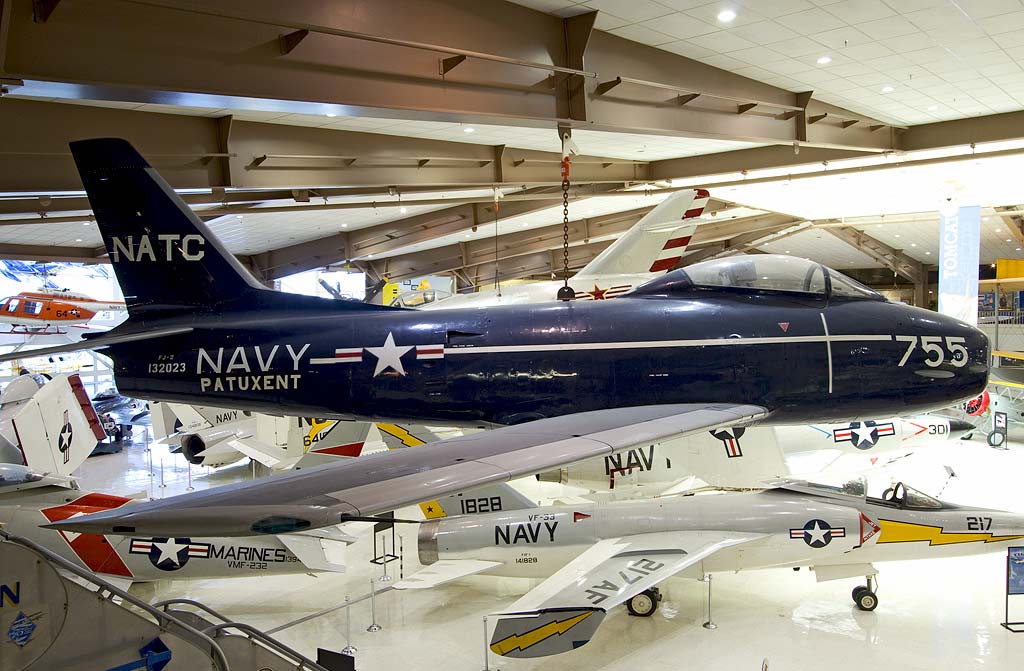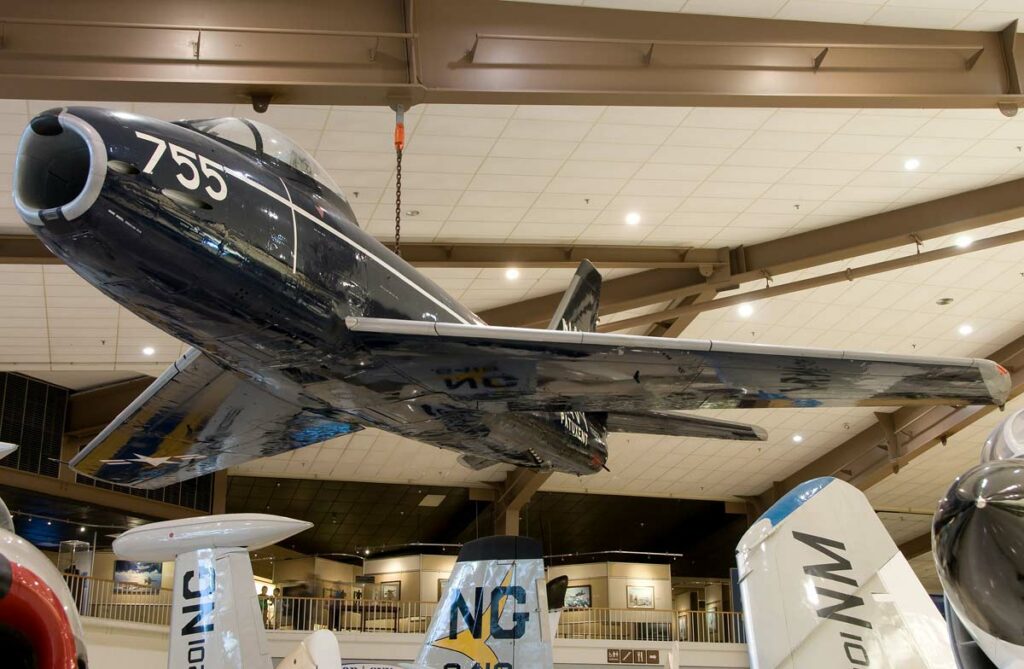The North American FJ-2 Fury was a carrier-capable variant of the renowned F-86 Sabre, designed specifically for the United States Navy and Marine Corps. Its development and various facets reflect a blend of innovation and adaptability in the era of jet-powered aviation.
A carrier-based jet fighter, the FJ-2 Fury was derived from the F-86 Sabre, equipped with folding wings and a high-performance jet engine.
In Brief
The North American FJ-2 Fury, a naval adaptation of the Air Force’s F-86 Sabre, was a carrier-capable fighter designed to meet the US Navy’s needs. Introduced in 1954, it featured a General Electric J47-GE-2 turbojet engine and folding wings to suit carrier operations. Plagued by operational challenges, particularly in carrier landings, the FJ-2 was primarily operated by the Marine Corps. Despite these issues, it showcased significant advancements in naval aviation, particularly in transitioning to jet-powered fighters. The FJ-2’s design led to the development of the FJ-3 Fury, which incorporated further improvements and became a mainstay in naval aviation.
The North American FJ-2 Fury represents a pivotal transition in naval aviation, marking the shift from propeller-driven to jet-powered aircraft on carriers. It stands as a testament to the adaptability and innovation in military aircraft design during the mid-20th century.

History of the Development of the North American FJ-2
Developed in the context of the Cold War and post-WWII military advancements, the FJ-2 Fury was a response to the evolving needs of naval aviation. The Korean War exposed the limitations of straight-wing jet fighters compared to Soviet MiG-15s, leading the Navy to seek a more capable fighter. North American Aviation, leveraging the success of the F-86 Sabre, proposed the FJ-2. This aircraft was to fulfill a dual role of air superiority and ground attack, a significant shift from the more specialized fighters of the era.
The program began with an emphasis on adapting the successful airframe of the F-86 for naval use, including modifications for carrier operations. The first prototype flew in December 1951, marking a significant milestone in the program. However, the FJ-2 faced several operational challenges, particularly in carrier landings, leading to its primary use by the Marine Corps.
The FJ-2’s development was concurrent with the FJ-3 model, which aimed to address some of the shortcomings of the FJ-2. This model featured a more powerful engine and improved wings, enhancing its overall performance and reliability.
Throughout its development, the FJ-2 represented a blend of proven design principles and innovative adaptations, setting the stage for more advanced naval fighters in the years to come.
Design of the North American FJ-2
The design of the FJ-2 Fury was heavily influenced by the need to operate effectively from aircraft carriers. It featured folding wings, a longer nose landing strut, and a reinforced structure to withstand the rigors of carrier operations. The aircraft was powered by a General Electric J47-GE-2 turbojet, providing substantial thrust but also presenting challenges in carrier-based operations.
The airframe’s dimensions included a length of 11.45 meters, a wingspan of 11.31 meters, and a height of 4.14 meters. The empty weight was approximately 5,353 kilograms, with a maximum take-off weight of 8,525 kilograms. These specifications underscored the Fury’s robust yet compact design, suitable for the confined spaces of a carrier.
The design’s advantages included improved speed and maneuverability over previous naval fighters, but it faced limitations in carrier landings and takeoffs due to its high-performance characteristics. The Fury’s design evolution, particularly in the FJ-3 variant, reflected ongoing efforts to balance these high-performance traits with the practical demands of naval aviation.
Performance of the North American FJ-2
In terms of performance, the FJ-2 Fury was a notable step forward for naval aviation. The General Electric J47-GE-2 turbojet engine delivered a thrust of 6,000 pounds, propelling the aircraft to a maximum speed of 676 mph. The service ceiling reached 46,916 feet, with a range of 994 miles. The Fury’s rate of climb was an impressive 7,230 feet per minute.
When compared to contemporaneous aircraft, the FJ-2’s performance was competitive, particularly in terms of speed and ceiling. However, operational challenges in carrier environments slightly tempered its effectiveness. The introduction of the FJ-3 model, with an even more powerful engine and improved wing design, addressed some of these performance issues, making it a more capable aircraft in the naval aviation context.
Variants of the North American FJ-2
- North American FJ-2:
The North American FJ-2, originally designated as the F-86E, was the first variant of the aircraft. It was based on the F-86 Sabre and featured a 6,100 lb thrust J47-GE-2 engine. The FJ-2 had six 0.50 caliber M3 Browning machine guns and could carry up to 2,000 lbs of bombs or rockets. - North American FJ-2B:
The FJ-2B was an improved version of the FJ-2, featuring upgraded avionics and navigation equipment. It had improved targeting capabilities, making it more effective in ground attack missions. - North American FJ-2M Fury:
The FJ-2M Fury was a modified version of the FJ-2, designed specifically for Marine Corps use. It featured reinforced landing gear to handle carrier landings and was equipped with folding wings for compact storage on aircraft carriers. - North American FJ-2D Fury:
The FJ-2D was an upgraded version of the FJ-2M, featuring enhanced radar systems and improved avionics. It was used primarily for air defense missions and had better all-weather capabilities. - North American FJ-2P Fury:
The FJ-2P was a photo-reconnaissance variant of the FJ-2, equipped with specialized cameras and sensors for intelligence gathering missions. It played a vital role in collecting valuable information during various conflicts.

Military Use and Combat of the North American FJ-2
Armament:
The primary armament of the North American FJ-2 consisted of six 0.50 caliber M3 Browning machine guns, which provided formidable strafing and dogfighting capabilities. Additionally, it could carry a variety of air-to-air rockets and bombs, making it versatile for both air-to-air combat and ground attack missions.
Conflicts:
The FJ-2 was used in several conflicts during its service life. One notable deployment was during the Korean War, where it engaged in air-to-air combat against Soviet-made MiG-15s. The FJ-2’s excellent speed and maneuverability allowed it to hold its own in dogfights, earning the respect of its pilots.
Missions and Battles:
During the Korean War, FJ-2s conducted numerous missions, including combat air patrols, ground attack missions, and interdiction sorties. They played a crucial role in protecting UN forces from enemy aircraft and providing close air support to ground troops.
The FJ-2 was also utilized during the Cuban Missile Crisis to provide reconnaissance and surveillance over the Caribbean, monitoring Soviet activities in the region.
Competing Aircraft:
The primary adversary of the FJ-2 during the Korean War was the Soviet MiG-15. While the MiG-15 was a formidable opponent, the FJ-2’s superior speed and firepower often gave it an edge in combat. It also faced other Soviet and Chinese-made fighter aircraft in various conflicts.
Export and Retirement:
The FJ-2 was not exported to other countries but remained in service with the United States Marine Corps. As newer and more advanced aircraft became available, the FJ-2 was gradually phased out in the late 1950s and early 1960s.
The North American FJ-2, with its various variants, played a significant role in defending UN forces during the Korean War and contributed to the surveillance efforts during the Cuban Missile Crisis. While it may not have enjoyed the same level of fame as some other aircraft of its era, the FJ-2 demonstrated its effectiveness in both air-to-air combat and ground attack missions. As military technology evolved, the FJ-2 was eventually retired, but its legacy lives on as a testament to its contributions in various conflicts.
Back to the Fighter Jet section.